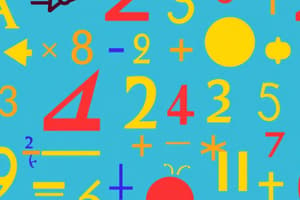Podcast
Questions and Answers
What is the sum of 10 and 5?
What is the sum of 10 and 5?
- 10
- 15 (correct)
- 20
- 5
What is 7 multiplied by 3?
What is 7 multiplied by 3?
- 24
- 21 (correct)
- 30
- 10
What is 20 divided by 4?
What is 20 divided by 4?
- 5 (correct)
- 6
- 8
- 4
Which number is greater, 12 or 18?
Which number is greater, 12 or 18?
What is the value of $x$ in the equation $x + 3 = 7$?
What is the value of $x$ in the equation $x + 3 = 7$?
Which of these numbers is an even number?
Which of these numbers is an even number?
What is 5 less than 15?
What is 5 less than 15?
What shape has three sides?
What shape has three sides?
What is the next number in the sequence: 2, 4, 6, ...?
What is the next number in the sequence: 2, 4, 6, ...?
Which of these is a symbol for subtraction?
Which of these is a symbol for subtraction?
Flashcards
Mathematics
Mathematics
The study of numbers, quantities, shapes, and their relationships using a specific notation.
Study Notes
- Math is the science and study of quantity, structure, space, and change.
- Mathematicians seek out patterns, formulate new conjectures, and establish truth by rigorous deduction from appropriately chosen axioms and definitions.
Arithmetic
- Arithmetic is the oldest and most elementary branch of mathematics.
- It deals with basic operations on numbers, namely addition, subtraction, multiplication, and division.
- Arithmetic provides the foundation for more advanced topics like algebra and calculus.
- The properties of operations such as commutativity, associativity, and distributivity are fundamental in arithmetic.
- Understanding number systems, including integers, rational numbers, and real numbers, is essential in arithmetic.
- Fractions, decimals, and percentages are key concepts in arithmetic, along with ratio and proportion.
Algebra
- Algebra is a branch of mathematics that generalizes arithmetic, using variables to represent numbers and relationships.
- It involves solving equations and inequalities to find unknown values.
- Algebraic expressions consist of variables, constants, and mathematical operations.
- Polynomials are a fundamental type of algebraic expression, involving sums of terms with variables raised to non-negative integer powers.
- Linear equations and systems of linear equations are a core topic in algebra, with applications in various fields.
- Quadratic equations and their solutions, including factoring, completing the square, and using the quadratic formula, are important.
- Functions, which describe relationships between variables, are a central concept in algebra, with various types like linear, quadratic, and exponential functions.
Geometry
- Geometry is the branch of mathematics concerned with the properties and relations of points, lines, surfaces, solids, and higher dimensional analogs.
- Euclidean geometry, based on Euclid's axioms, deals with shapes like triangles, circles, and polyhedra in a two-dimensional or three-dimensional space.
- Coordinate geometry, also known as analytic geometry, uses algebra to describe geometric shapes and solve geometric problems.
- Trigonometry studies the relationships between angles and sides of triangles, using trigonometric functions like sine, cosine, and tangent.
- Transformations, such as translations, rotations, and reflections, are studied in geometry to understand how shapes can be manipulated.
- Concepts like area, volume, perimeter, and surface area are important for measuring geometric shapes.
Calculus
- Calculus is the branch of mathematics that deals with continuous change.
- It is divided into two main branches: differential calculus and integral calculus.
- Differential calculus focuses on the rate of change of functions and the concept of the derivative.
- Integral calculus deals with the accumulation of quantities and the concept of the integral.
- Limits are a fundamental concept in calculus, providing the foundation for derivatives and integrals.
- Derivatives are used to find slopes of curves, optimization problems, and rates of change in various applications.
- Integrals are used to find areas under curves, volumes of solids, and to solve differential equations.
- The fundamental theorem of calculus connects differentiation and integration, showing they are inverse operations.
Trigonometry
- Trigonometry is the study of relationships between angles and sides of triangles.
- The primary trigonometric functions are sine (sin), cosine (cos), and tangent (tan).
- These functions relate angles of a right triangle to the ratios of its sides.
- Trigonometric identities are equations that are true for all values of the variables involved.
- The unit circle is a valuable tool for understanding trigonometric functions and their values.
- Trigonometry is used in various applications, including navigation, surveying, and physics.
- Inverse trigonometric functions are used to find angles corresponding to given trigonometric ratios.
Statistics and Probability
- Statistics is the science of collecting, analyzing, interpreting, and presenting data.
- Descriptive statistics involves summarizing and describing data using measures like mean, median, mode, and standard deviation.
- Inferential statistics involves making inferences and generalizations about a population based on a sample of data.
- Probability is the measure of the likelihood that an event will occur.
- Probability is expressed as a number between 0 and 1, where 0 indicates impossibility and 1 indicates certainty.
- Random variables are variables whose values are numerical outcomes of a random phenomenon.
- Probability distributions describe the probabilities of different values of a random variable.
Studying That Suits You
Use AI to generate personalized quizzes and flashcards to suit your learning preferences.




